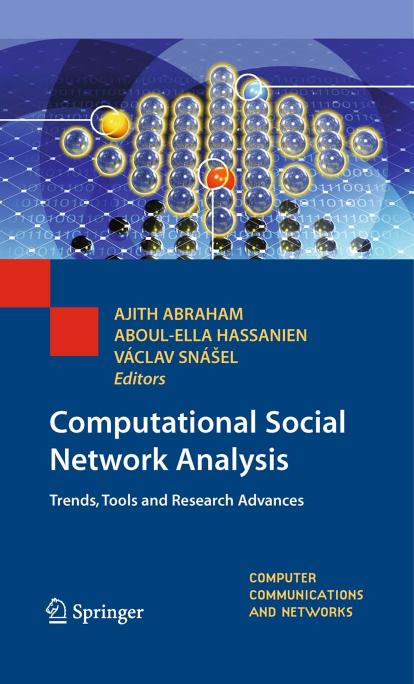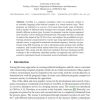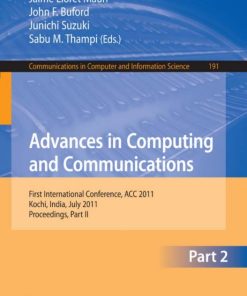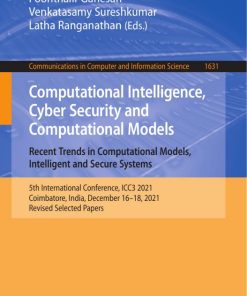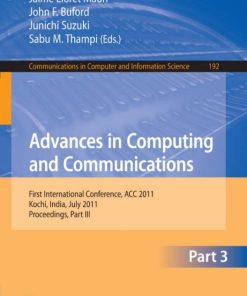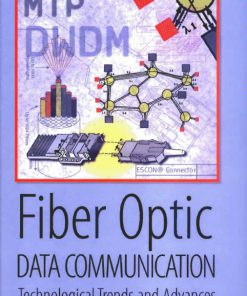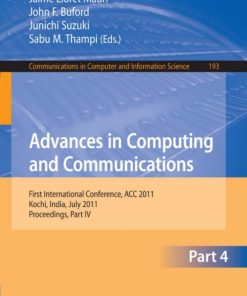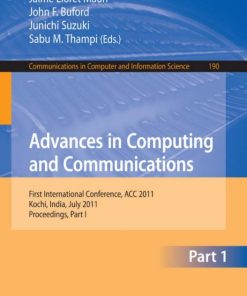Computational Social Network Analysis Trends Tools and Research Advances 1st Edition by Ajith Abraham, Aboul Ella Hassanien, Vaclav Snasel ISBN 1848822294 9781848822290
$50.00 Original price was: $50.00.$25.00Current price is: $25.00.
Authors:Ajith Abraham, Aboul-Ella Hassanien, Vaclav Snásel , Tags:ISBN-13:; 9781848822283 , Author sort:Ajith Abraham, Aboul-Ella Hassanien, Vaclav Snásel , Languages:Languages:eng , Published:Published:Apr 2010 , Comments:Comments:Springer
Computational Social Network Analysis Trends, Tools and Research Advances 1st Edition by Ajith Abraham, Aboul-Ella Hassanien, Vaclav Snásel – Ebook PDF Instant Download/Delivery. 1848822294, 9781848822290
Full download Computational Social Network Analysis Trends, Tools and Research Advances 1st Edition after payment
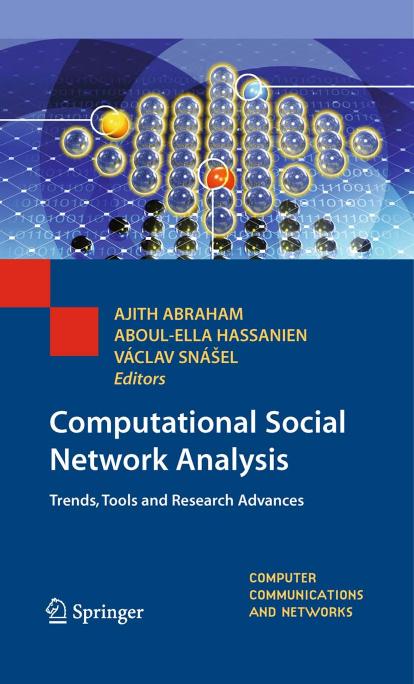
Product details:
ISBN 10: 1848822294
ISBN 13: 9781848822290
Author: Ajith Abraham, Aboul-Ella Hassanien, Vaclav Snásel
Social networks provide a powerful abstraction of the structure and dynamics of diverse kinds of people or people-to-technology interaction. Web 2.0 has enabled a new generation of web-based communities, social networks, and folksonomies to facilitate collaboration among different communities. This unique text/reference compares and contrasts the ethological approach to social behavior in animals with web-based evidence of social interaction, perceptual learning, information granulation, the behavior of humans and affinities between web-based social networks. An international team of leading experts present the latest advances of various topics in intelligent-social-networks and illustrates how organizations can gain competitive advantages by applying the different emergent techniques in real-world scenarios. The work incorporates experience reports, survey articles, and intelligence techniques and theories with specific network technology problems. Topics and Features: Provides an overview social network tools, and explores methods for discovering key players in social networks, designing self-organizing search systems, and clustering blog sites, surveys techniques for exploratory analysis and text mining of social networks, approaches to tracking online community interaction, and examines how the topological features of a system affects the flow of information, reviews the models of network evolution, covering scientific co-citation networks, nature-inspired frameworks, latent social networks in e-Learning systems, and compound communities, examines the relationship between the intent of web pages, their architecture and the communities who take part in their usage and creation, discusses team selection based on members’ social context, presents social network applications, including music recommendation and face recognition in photographs, explores the use of social networks in web services that focus on the discovery stage in the life cycle of these web services. This useful and comprehensive volume will be indispensible to senior undergraduate and postgraduate students taking courses in Social Intelligence, as well as to researchers, developers, and postgraduates interested in intelligent-social-networks research and related areas.
Computational Social Network Analysis Trends, Tools and Research Advances 1st Table of contents:
Part I Social Network Mining Tools
1 An Overview of Methods for Virtual Social Networks Analysis
1.1 Introduction
1.2 Background
1.3 Categorisation of Motivational Factors
1.4 Virtual Social Network Analysis
1.4.1 Network Data Collection
1.4.1.1 Socio-Centric Network Method
1.4.1.2 Ego-Centric Network Method
1.4.2 Network Data Visualisation
1.4.2.1 Graphs
1.4.2.2 Matrices
1.4.2.3 Maps
1.4.2.4 A Hybrid Approach
1.5 Application Scenario: The Case of LinkedIn
1.5.1 Fist Phase
1.5.2 Second Phase
1.6 Conclusion
References
2 Discovering Sets of Key Players in Social Networks
2.1 Introduction
2.2 Information Theory in SNA
2.3 Methods for Discovering Sets of Key Players
2.4 Discovering Sets of Key Players Using Entropy Measures
2.4.1 Applying Entropy Measures to More Complex Social Networks
2.5 Conclusions and Future Work
References
3 Toward Self-Organizing Search Systems
3.1 Introduction and Motivation
3.2 Self-Organizing Search Systems
3.2.1 Similarity Search Systems
3.2.2 Self-Organizing Systems
3.2.2.1 Application Areas
3.3 Three-Layer Model of Self-Organizing Search Systems
3.3.1 Abstract Layer
3.3.1.1 Knowledge
3.3.1.2 Behavior
3.3.1.3 Abilities
3.3.1.4 Query Processing
3.3.1.5 Announcement or Advertising
3.3.1.6 Node Management
3.3.2 Conceptual Layer
3.3.3 Implementation Layer
3.4 Building a Social-Network Search System
3.4.1 Conceptual Layer
3.4.1.1 Knowledge
3.4.1.2 Data Repository
3.4.1.3 Semantic Links
3.4.1.4 Behavior
3.4.1.5 Abilities
3.4.1.6 Query Processing
3.4.1.7 Announcement
3.4.1.8 Advertisement
3.4.2 Implementation Layer
3.4.3 Implementation Summary
3.5 Experimental Evaluation of mSN
3.5.1 Measures
3.5.2 Analysis of Self-Adaptability
3.5.3 Clustered-Data Assignment Evaluation
3.5.4 Data-Owner Assignment Evaluation
3.6 Conclusion and Future Enhancements
References
4 DISSECT: Data-Intensive Socially Similar Evolving Community Tracker
4.1 Introduction
4.2 Finding Subgroups for Tracking Community
4.2.1 Centrality
4.2.2 Cohesive Subgroups and Clustering
4.2.2.1 Clique and k-Plex Analysis
4.2.2.2 Clustering and Partitioning
4.2.2.3 Summary
4.2.3 Similarity
4.3 Tracking Online Community Interactions Using the SCAN Method
4.3.1 Social Cohesion Analysis of Networks (SCAN) Method
4.3.1.1 Select
4.3.1.2 Collect
4.3.1.3 Choose
4.3.2 Application and Limitations of the SCAN Method
4.4 Data-Intensive Socially Similar Evolving Community Tracker (DISSECT)
4.4.1 Framework for the DISSECT Method
4.4.1.1 Find the Initial Time Periods for Analysis
4.4.1.2 Label Subgroups of People from the Network Dataset Using Content Analysis and Semantic Prope
4.4.1.3 Select the Possible Members of Known Subgroupsthat You Want to Track (from the Previous Step
4.4.1.4 Cluster Analysis to Infer Possible Subgroups
4.4.1.5 Repeat the Steps in Sects. 4.4.1.3 and 4.4.1.4 for Different Values of Centrality
4.4.1.6 Calculating Similarity
4.4.1.7 Repeat Steps in Sects. 4.4.1.2 Through 4.4.1.6 for All Possible Time Period Intervals and Co
4.4.2 Using DISSECT to Identify Community Evolution
4.4.2.1 Behavioral Measures for Evaluating Subgroups
4.5 Conclusion
4.5.1 Applications
4.5.1.1 Marketing
4.5.2 Expertise Location
4.5.3 Information Search
References
5 Clustering of Blog Sites Using Collective Wisdom
5.1 Introduction
5.2 Related Work
5.2.1 Blog Clustering
5.2.2 Leveraging Tag Information
5.3 Problem Definition
5.4 Generating Similarity for Blog Clustering
5.4.1 Wisdom: Leveraging Collectivism
5.4.2 A Conventional Approach
5.5 Experiments and Discussion
5.5.1 Design and Methodology
5.5.2 Results and Analysis
5.5.2.1 Link Strength
5.5.2.2 Label Hierarchy
5.5.2.3 Visualizations – Pajek
5.5.2.4 k-Means vs. Hierarchical Results
5.6 Conclusions and Future Work
References
6 Exploratory Analysis of the Social Network of Researchers in Inductive Logic Programming
6.1 Introduction
6.2 The ILPnet2 Database
6.3 Data Preprocessing for Social Network Analysis
6.4 ILPNet2 Social Network Analysis
6.4.1 Cohesion
6.4.2 Brokerage
6.4.3 Ranking
6.5 Document Analysis: Background Text Mining Technologies
6.5.1 OntoGen
6.5.2 TermExtractor
6.6 The OntoTermExtraction Methodology
6.6.1 Steps in the Proposed OntoTermExtraction Methodology for Concept Naming
6.6.2 Populating the Terms and Keyword Extraction
6.7 ILPnet2 Vocabulary and Ontology Construction
6.7.1 Vocabulary Extraction
6.7.2 Ontology Learning
6.8 Summary
References
7 Information Flow in Systems of Interacting Agents as a Function of Local and Global Topological Fe
7.1 Introduction
7.2 Methods
7.2.1 Boolean Networks as Models of Systems of Interacting Elements
7.2.2 Mutual Information as a Measure of Information Flow
7.2.3 Generalized Clustering Coefficient
7.2.4 Lempel–Ziv Complexity
7.3 Results
7.3.1 Mutual Information as a Function of the Global Topology
7.3.2 Effects of Local Topology on Global Dynamics
7.3.3 Dynamics of Lattice Structures
7.3.4 Information Propagation and Retention in Noisy BNs. Implications to a Model of Human Organizat
7.4 Conclusions
References
Part II Social Network Evolution
8 Network Evolution: Theory and Mechanisms
8.1 Introduction
8.2 Preliminary Concepts
8.2.1 Power-Law Distribution
8.2.2 Erdös–Rényi Random Graph Model
8.3 Barabási–Albert Model
8.3.1 Master-Equation Approach
8.3.2 Properties of the BA Model
8.3.2.1 Degree Distribution of BA Model: Continuum Approach
8.3.2.2 Clustering Coefficient
8.3.2.3 Average Path Length
8.3.2.4 Degree Correlations
8.3.3 Generalization of Preferential Attachment: Rate Equation Approach
8.4 Network Growing with Aging
8.5 Fitness Model
8.5.1 Pure Additive Fitness
8.5.2 Pure Multiplicative Fitness
8.5.3 Mixed Multiplicative and Additive Fitness
8.5.4 Bose–Einstein Condensation
8.6 Local Strategy
8.6.1 Rewiring Model
8.6.2 Random Walk Model
8.6.3 Copying Mechanism
8.6.4 Duplication-Divergence Model
8.7 Self-Similarity in Growing Networks
8.8 Deterministic Growth Models
8.8.1 Barabási–Ravasz–Vicsek Model
8.8.2 Pseudofractal Scale-Free Web
8.8.3 Geometric Fractal Growth Model
8.9 Self-Organization Network Models
8.9.1 Self-Organization of Communication and Topology
8.9.2 Merging and Regeneration
8.10 Conclusion
References
9 Vmap-Layout, a Layout Algorithm for Drawing Scientograms
9.1 Introduction
9.2 A Methodology to Generate Scientograms
9.2.1 Category Co-citation Measure
9.2.2 Network Pruning by Pathfinder
9.2.3 Network Layout by Kamada–Kawai
9.2.4 Advantages and Drawbacks of Our Methodology
9.2.5 The Use of Other Network Layout Algorithms for Social Networks Drawing
9.3 Overview of the Algorithm
9.3.1 Main Algorithm
9.3.2 Attribute Computation
9.3.3 Node Positioning
9.3.4 Node Relocation
9.3.5 Selecting Different Initial Polygons
9.3.6 Selecting Different Ways to Compute the Central Point of a Polygon
9.3.7 Selecting Different Dividing Slice Methods
9.3.8 Details on the Node Relocation Function
9.4 Experiments
9.5 Conclusion
References
10 Nature-Inspired Dissemination of Information in P2P Networks
10.1 Introduction
10.2 Networks and Communication Schemes
10.2.1 Network Structures
10.2.2 Communication Schemes
10.3 Nature-Inspired Communication Paradigms
10.3.1 Epidemic and Rumour Spreading
10.3.2 Stigmergy
10.3.3 Immune System
10.3.4 Comparison
10.4 Nature-Inspired Algorithms for Communication
10.4.1 Information Querying
10.4.1.1 Centralised Indexes
10.4.1.2 Local Indexes
10.4.1.3 Distributed Indexes
10.4.2 Dissemination of Information
10.4.2.1 Selective and Directed Dissemination
10.4.2.2 Blind Dissemination
10.4.3 Modification of the Topology
10.4.3.1 Rewiring
10.4.3.2 Adding Shortcuts
10.5 Achieving Network-Level Stigmergy
10.5.1 General Objectives
10.5.2 Architecture
10.5.2.1 Management of Stacks
10.5.2.2 Management of Communications
10.5.2.3 Management of Connections
10.5.3 Results and Applications
10.6 Conclusion
References
11 Analysis and Visualization of Relations in eLearning
11.1 Introduction
11.2 Data Mining
11.2.1 Data Reduction
11.2.2 Cluster Analysis
11.2.2.1 Hierarchical Methods
11.3 Learning Management Systems
11.3.1 Data Mining and eLearning
11.4 Social Networks
11.4.1 Recent Work
11.4.2 Online Social Networks
11.4.3 Evolution of Social Networks
11.4.4 Sequential Pattern Mining
11.5 Social Network Analysis
11.5.1 Patterns Mining
11.5.2 Measures in Social Network Analysis
11.5.3 eTutors
11.5.4 Software for Social Network Analysis
11.6 Visualization of Social Networks
11.6.1 Node-Link Diagram or Matrix Representation of Network
11.6.2 Clustered Graph Representation
11.6.3 Software for Visualization
11.7 Experimental Design
11.7.1 Definitions
11.7.2 Division of a Students Group into Subgroups
11.7.3 Experiment Results
11.8 Conclusion
References
12 Interdisciplinary Matchmaking: Choosing Collaborators by Skill, Acquaintance and Trust
12.1 Introduction
12.2 Related Work: Concepts, Approaches and Techniques for Team Recommendation
12.2.1 Recommendation Systems
12.2.2 Social Networks
12.2.3 Theories of Team Recommendation
12.2.3.1 Social Capital
12.2.3.2 Individual Social Capital
12.2.3.3 Group Social Capital
12.2.4 Teams and Trust
12.2.5 Knowledge
12.2.5.1 Knowledge in Social Sciences
12.2.5.2 Knowledge Representation
12.2.5.3 Knowledge in Social Networks
12.2.6 Summary
12.3 Three-Dimensional Social Network: A Model for a Social Environment
12.4 Predicting Quality of Team Performance
12.4.1 Social Capital
12.4.2 Intra-Group Trust
12.4.3 Matching Team’s Knowledge with Project Requirements
12.4.4 Multicriteria Optimization
12.5 Experiments
12.5.1 3DSN in onephoto.net
12.5.2 Dependencies Between Dimensions in Social Networking Data
12.6 Concluding Remarks and Future Work
References
13 Web Communities Defined by Web Page Content
13.1 Introduction
13.2 From Web Pages to Web Communities
13.2.1 Microgenres
13.2.1.1 Microgenre Recognition
13.2.2 Web Page Description
13.3 Related Work
13.4 Tools and Techniques
13.4.1 Pattrio Method
13.4.1.1 Pattrio Catalog
13.4.1.2 Example – Discussion (Forum)
13.4.1.3 Detection Algorithm
13.4.1.4 Method Accuracy
13.4.2 Formal Concept Analysis
13.4.2.1 FCA Basics
13.5 Experiments
13.5.1 Web Site Visualization
13.5.2 Web Site Clustering
13.6 Conclusions and Future Work
References
14 Extended Generalized Blockmodeling for Compound Communities and External Actors
14.1 Introduction
14.2 The Community Protection Approach
14.3 Short Description of Algorithms
14.4 Example
14.5 Conclusions
References
15 Analyzing Collaborations Through Content-Based Social Networks
15.1 Introduction
15.2 Identification of Themes of Interest in a Social Network
15.2.1 Summary of the Topic Extraction Methodology
15.2.2 Experiments on Topic Clustering
15.3 The Content-Based Social Network
15.3.1 Modeling the Content-Based Social Network
15.3.2 Social Network Measures
15.3.3 Analysis of a Research Network
15.3.3.1 Facilitating Governance of Research Networks
15.3.3.2 Network Evolution over Time
15.3.4 Summary of Findings
15.4 Conclusions
References
Part III Social Network Applications
16 IA-Regional-Radio – Social Network for Radio Recommendation
16.1 Introduction and Issue
16.2 General System Architecture
16.3 Text Mining
16.3.1 Representation of Documentary Corpus
16.3.2 Classification Techniques
16.4 Sentiment Analysis
16.4.1 The Complexity of Opinion Marking
16.4.2 Detection of Subjective Phrases
16.4.3 The Opinion Polarity and Intensity
16.4.4 Different Approaches for the Sentiment Analysis
16.5 Linguistic Analysis
16.6 Opinion Marking Module
16.6.1 The Group Behavior Classifier
16.6.2 The Statistical Classifier
16.6.3 The Linguistic Classifier
16.6.4 The Final Classifier
16.7 Results
16.8 Conclusion
References
17 On the Use of Social Networks in Web Services: Application to the Discovery Stage
17.1 Introduction
17.2 Background
17.2.1 Definitions
17.2.2 Some Works on Social Networks
17.3 Social Network-Based Web Services Discovery
17.3.1 Social Networks Building
17.3.2 Social Networks Use
17.3.3 Social Networks Maintenance
17.4 Experiments as Ongoing Efforts
17.5 Conclusion
References
18 Friends with Faces: How Social Networks Can Enhance Face Recognition and Vice Versa
18.1 Introduction
18.1.1 Background
18.1.2 Overview
18.2 Utilizing Social Context Towards Face Recognition
18.2.1 Basic Concepts
18.2.2 Basic Problems and Classes of Algorithms
18.2.3 The Proposed Algorithms in Detail
18.2.3.1 Algorithm 0
18.2.3.2 Algorithm 1
18.2.3.3 Algorithm 2
18.2.3.4 Algorithm 3
18.2.4 Empirical Investigation
18.2.4.1 Data Acquisition
18.2.4.2 Facebook Site Mechanism and Security
18.2.4.3 Facebots Data Access
18.2.5 A First Look at the Data Sets
18.2.5.1 A Closer Look at the Data Sets
18.2.6 Results and Commentary
18.2.6.1 Tuning Alphas and Betas
18.2.7 Predicting Scalability
18.2.7.1 The Testbed
18.2.7.2 Recognition Performance and Training Set Size
18.3 Using Co-occurrence in Photos Towards Estimation of The Friendship Network
18.3.1 Introduction and Problem Setting
18.3.2 Proposed Algorithms
18.3.2.1 Algorithm 4
18.3.3 Results
18.4 Conclusion
People also search for Computational Social Network Analysis Trends, Tools and Research Advances 1st:
computational social network analysis
computational social network analysis trends tools and research advances
social network analysis examples
what is social network analysis
social network analysis jobs

